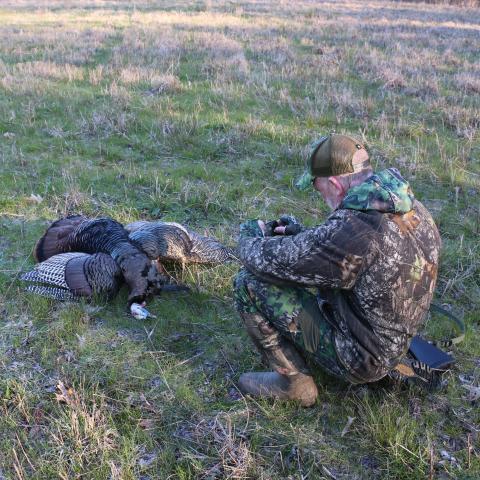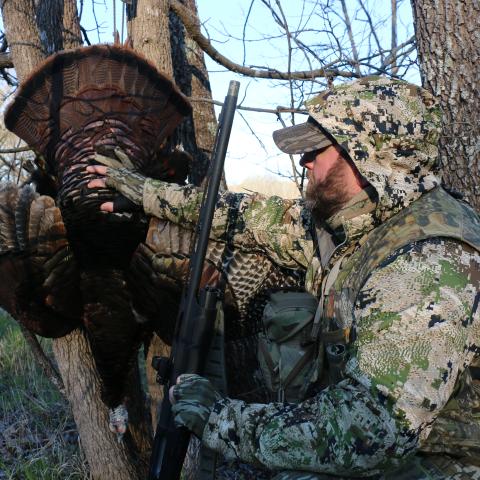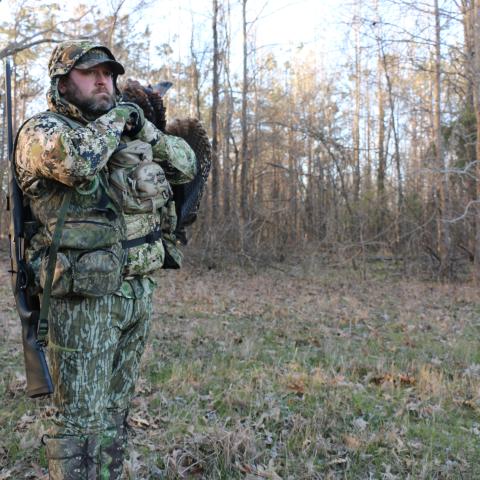Deep-South Chills: The Quest for Early Turkeys
In response, many turkey geeks hit the road, traveling to Southern states with earlier openers. Trouble is, many popular destinations in the heart of Eastern turkey country have modified their season structures and open later nowadays, and that prompts some serious headaches for winter-weary hunters in need of a gobbler fix.
Enter Mississippi. With a March 15 opener and solid turkey populations that have been on the upswing the past two or three years, the Magnolia State might provide the perfect venue to kick off spring. At least that’s what I figured. Tired of winter, and with my 2023 turkey calendar free of hunts until mid-April, I decided to head to Mississippi in mid-March to start spring early.
My first step was to acquire a new Benelli M2 Field shotgun in 20-gauge. With the rise of TSS loads, smaller gauges have become serious turkey medicine. I then affixed a Burris FastFire 4 red-dot sight to the gun via SpeedBead Mount. Fiocchi loads of No. 9 TSS shot completed the package. A cold yet quick early-March range session let me zero in the gun and produced ridiculously thick, consistent patterns at 30 yards and farther.
The gun was ready, and I was anxious. I just had to get to Mississippi.
Chilly Arrival
Not surprisingly, an overnight snowstorm delayed my St. Patrick Day flights, so I didn’t arrive in Memphis, Tennessee, until after 5 p.m. A bit later, I steered my rental vehicle southeast toward Holly Springs, Mississippi, where I’d meet my host, Robert Woods, owner of Cuffawa Creek Outfitters.
“It’s going to be a little cold, but I think you’ll have a good hunt,” Woods said as we met for dinner that evening. “Bird numbers look solid.”
That’s all I needed to hear. After supper, I arranged my gear in the hotel room and tried to get my mind back in turkey mode.
The first morning dawned cloudy and cold, with temperatures I thought I’d left in the frozen North. Still, as we listened near Woods’ truck, a gobbler greeted the dawn about 600 yards away, and the game was on.
Slipping as close as we dared, Woods and I stopped behind a point of hardwoods to assess the situation. Two gobblers answered a crow 100-some yards away, and we decided it was wise to back up a bit and call there. As we set up, several other birds in the distance fired up.
The closest gobblers answered my tree yelps on the limb and then gobbled fairly regularly after flying down. They didn’t move much closer, however, so I figured some silence might spark their curiosity. Sure enough, after a brief break, two raucous gobbles split the air the next time I yelped, and it became obvious the birds were coming.
I saw the first gobbler at about 70 yards, ducking out of some pines and into a slight depression before the hardwoods. Two others followed. Seconds later, the lead longbeard approached to 40-some yards and craned its neck high — behind a shield of tangled brush. Knowing I had no shot, I waited and hoped the bird would move right and stay within range.
I got half of my wish. The gobbler eased to our right but ducked below the point and slowly moved away. His buddies followed, gobbling. Soon, they were out of our lives, and Woods and I lamented the oh-so-close encounter.
No matter, he said. The morning was young, and other birds awaited.
The remainder of the day didn’t lack for adventure. Woods and I tried to slip toward to a big breeding flock in a field, but the gobbler and his hens moved off before we got close. Another property brought two encounters with gobblers — one with hens and one solo. Neither wanted to play the game. And about 9 a.m., the wind began to gust, and hunting got more difficult. We yelped in several batches of hens and jakes later, but longbeards eluded us.
A last-minute scouting trip brought hope, however. Woods pulled his truck down a long two-track and stopped suddenly. A quick glance through binoculars revealed a lone longbeard at the edge of a large field. We watched the bird enter the woods, guessed where he might roost and then made plans for the morning.
Day 2, we figured, might start with a bang.
Frigid Quiet
We began earlier the second morning, hoping to slip under the roosted gobbler. A bit drowsy, I rubbed my eyes and hoped the truck thermometer was lying. Nope, 26 degrees. And the frigid north wind from the previous day hadn’t let up much. So much for the sunny South.
Woods and I sneaked into the woods, found two stout white oaks and settled in for a wait. Dawn began to break minutes later, and I expected to hear drumming nearby.
No dice. Perhaps the bird had roosted deeper in the woods, I figured, so I listened intently for the day’s first gobble.
Thirty minutes later, it became apparent that nothing would gobble that morning. Further, our “roosted” gobbler was nowhere nearby. Chilled and flummoxed, Woods and I headed for the truck and debated our next move.
“Hilltop or bottoms?” he asked. I chose the former, which is where we’d worked the three gobblers close the previous morning. Woods steered the truck onto the asphalt and began the trip but quickly changed his mind.
“Let me just check another piece before we go there,” he said. “It’s not far, and the bottoms where that bird walked in last night connects to it.”
That sounded good to me, especially because Woods knows his ground and I do not. And when we pulled up to the spot, I saw why he wanted to check it. Beautiful open hardwoods spilled into a picturesque creek bottom. A sprawling field sat to the west, bordered on both sides by pretty timber. It just looked like a turkey spot.
After glassing the field and locating a nifty setup, Woods and I sat and prepared to call for a half-hour. My first soft yelps and clucks echoed through the sun-splashed creek bottom but brought only silence.
“Easy on the yelper,” I said, reminding myself not to get crazy with calling. Besides, my fingers were numb from running the slate.
About 15 minutes and two calling series later, I glanced to my right and wondered what we should do next. The hilltop spot seemed obvious, but if turkeys weren’t gobbling, it might be tough hunting big timber. Perhaps the open fields where we’d flirted with the two other birds would be better.
That’s when I saw it. My head eased back to the left to reveal a silent gobbler about 100 yards away on a steady approach. Stunned, I told myself to remain still. The bird paused at about 75 steps to strut, and then turned left, placing a large tree between us.
Ultra-slowly, I eased the gun to my shoulder, waited for the longbeard to reappear and then found him in the red-dot. The turkey was within range and drifting left, but it suddenly stopped and ran its head high. Knowing the gobbler wouldn’t stick around long after not seeing the hen it had heard, I figured the moment had arrived. The Benelli barked, and our frigid morning instantly got warmer.
Trust the Plan
Woods joined me in the field by the flopping bird, and we exchanged congratulations. The Mississippi gobbler wore sharp 1-inch spurs and a dandy beard. Moreover, the hunt had been a testament to a common-sense approach and stick-to-it-iveness.
After taking photos, we lugged the gobbler to the truck, still reveling in our surprise success. It would be weeks before most other spring seasons opened, so it was especially satisfying to get a jump-start on the turkey campaign — even if Mississippi’s March weather felt just like a cold Northern winter.





